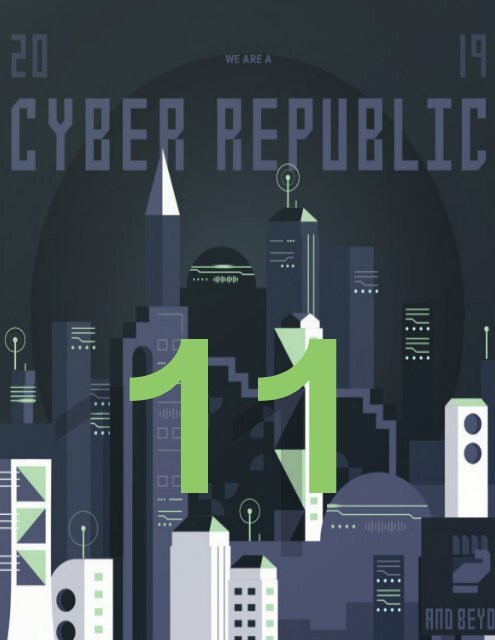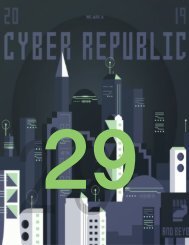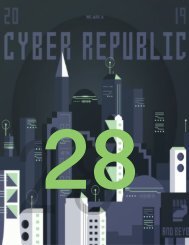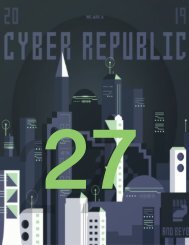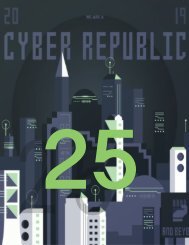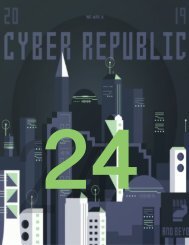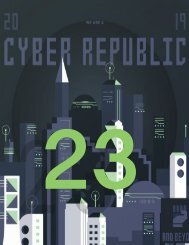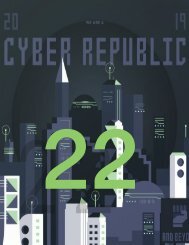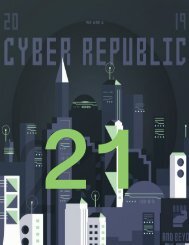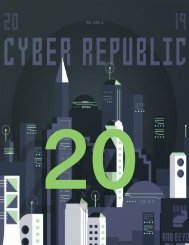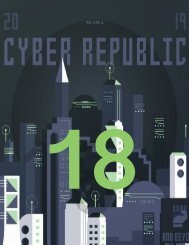Cyber Republic Weekly Update 11
Welcome, believers of the new internet. First of all, Happy Chinese New Year! This week has several intriguing updates about Elastos and the Cyber Republic. Elastos announced the unbelievable accomplishment of launching 1 million carrier nodes. Next, there was the unveiling of the official Elastos EOY Report. There's also a new DMA 1.0 Beta update, a React Native suggestion seeking votes, and an out-of-the-box idea on the CR Forum. Let's get into it.
Welcome, believers of the new internet. First of all, Happy Chinese New Year! This week has several intriguing updates about Elastos and the Cyber Republic. Elastos announced the unbelievable accomplishment of launching 1 million carrier nodes. Next, there was the unveiling of the official Elastos EOY Report. There's also a new DMA 1.0 Beta update, a React Native suggestion seeking votes, and an out-of-the-box idea on the CR Forum. Let's get into it.
You also want an ePaper? Increase the reach of your titles
YUMPU automatically turns print PDFs into web optimized ePapers that Google loves.
<strong>11</strong><br />
//1
CYBER REPUBLIC <strong>Weekly</strong> <strong>Update</strong>/Issue <strong>11</strong><br />
Welcome, believers of the new internet.<br />
First of all, Happy Chinese New Year!<br />
This week has several intriguing updates<br />
about Elastos and the <strong>Cyber</strong> <strong>Republic</strong>.<br />
Elastos announced the unbelievable<br />
accomplishment of launching 1 million<br />
carrier nodes. Next, there was the unveiling<br />
of the official Elastos EOY Report. There's<br />
also a new DMA 1.0 Beta update, a React<br />
Native suggestion seeking votes, and an<br />
out-of-the-box idea on the CR Forum. Let's<br />
get into it.<br />
On January 28th, the Elastos Foundation<br />
officially announced the 1 million node<br />
mark. Through their strategic hardware<br />
partnership with Shanghai Shijiu TV, it has<br />
been an outstanding success since it<br />
deployed in August of 2018. Each one of the<br />
Shijiu TV Boxes contains a node on Elastos'<br />
decentralized carrier (P2P network) that<br />
“circumvents the traditional “client-server”<br />
model where one's device needs to<br />
connect to a centralized server. Elastos<br />
stands out as the first Web 3.0 project to<br />
reach the 1 million node milestone. Plans<br />
with Shijiu TV for 2019 include further<br />
applying DID in IoT devices (i.e. TV boxes),<br />
the use of DID to link internet users to the<br />
blockchain, and promoting the TV boxes that<br />
provide basic node network services for the<br />
modern internet.<br />
The next set of important news is in the<br />
awaited Elastos End-of-Year report. We want<br />
to share some important pieces regarding<br />
the <strong>Cyber</strong> <strong>Republic</strong>:<br />
It has been re-emphasized that the Elastos<br />
Foundation is fully dedicated to the gradual<br />
transfer of power to the <strong>Cyber</strong> <strong>Republic</strong>.<br />
Elastos sees the CR as a platform of<br />
meaningful involvement - the Foundation<br />
encourages people to contribute as<br />
opportunities become available. Some<br />
important milestones on the roadmap<br />
include the <strong>Cyber</strong> <strong>Republic</strong> Elections in June<br />
and in Q3, the <strong>Cyber</strong> <strong>Republic</strong> official launch<br />
where everything has been handed over to<br />
the community as a fully operational and selfgoverned<br />
decentralized organization. After<br />
the Elections have concluded in August of<br />
2019, the Elastos Foundation's role will be<br />
greatly diminished. Marketing, PR, and<br />
community activities will solely be run by<br />
members of the CR community.<br />
//2
DMA (Decentralized Marketing<br />
Platform) has come out with their 1.0<br />
Beta release details.<br />
https://medium.com/@elastosdma/elast<br />
o s - d m a - 1 - 0 - b e t a - r e l e a s e - n o t e s -<br />
e72f94e2ba2c<br />
Included in the DMA 1.0 beta release is<br />
the base and service layer.The base layer<br />
acts as a connector to the Elastos<br />
infrastructure, which provides private<br />
APIs to the service layer. The service<br />
layer puts together the base layer and<br />
asset management business logic and<br />
provides public APIs to Dapp developers.<br />
Five modules (Passport, Asset<br />
Management, Wallet, Storage, Utility)<br />
can be accessed by developers via their<br />
Public APIs for Asset Management<br />
purposes. Developers with experience<br />
can customize these modules to their<br />
liking. The sixth module, Merchant, is an<br />
all-in-one suite of merchant-related<br />
business logic--a nifty tool to build on for<br />
developers.<br />
Uptick, the inaugural dAPP powered by<br />
DMA, contains a specific ticketing layer<br />
(Uptick Ticket Service) along with clients<br />
for consumers and merchants (Uptick<br />
Merchant dApp client and Uptick<br />
Android dAPP client. This month DMA<br />
plans to roll out a real business plan for<br />
the Uptick project, so stay tuned!<br />
There's a new program in DMA called the<br />
“Early Access Program”. (EAP) DMA is<br />
looking to corral 3-5 projects for which<br />
they will provide technical support.<br />
Included in this initiative will be<br />
continued business development and<br />
localisation of the Uptick dApp. DMA<br />
wants Uptick to be run by the community<br />
in a decentralized fashion. If you are<br />
interested, please contact the team with<br />
messages and proposals by the end of<br />
February.<br />
(EarlyAccess@elastosDMA.org)<br />
All materials included in the DMA 1.0 beta<br />
release will be posted on its website<br />
within the next couple of weeks.<br />
(www.elastosDMA.org)<br />
Shout out to one of the CR community<br />
members, Econymous, for publishing an<br />
enlightening idea for the <strong>Cyber</strong> <strong>Republic</strong><br />
ecosystem.<br />
https://forum.cyberrepublic.org/t/perpet<br />
ual-funding-perfect-participationdistribution-for-daos/493/7<br />
The author is trying to achieve fair<br />
distribution through a smart contract<br />
that ultimately can be “used to enhance<br />
the delegate layer of DPOS sidechains,<br />
sharding...or function as the fundraising<br />
and governance distribution mechanism<br />
for DAO's”. This contract is made up of<br />
“bonds” that it generates based on buys<br />
and sells. Every time someone buys the<br />
contract with ELA, the price and supply<br />
increases. Whenever someone sells the<br />
price, the supply decreases (bonds<br />
burned). Whenever a bond is sold the<br />
user gets “resolve tokens” in return.<br />
Here is the formula: Resolve tokens =<br />
input ELA * ( input ELA / output ELA ) An<br />
example is if someone spends 10 ela on a<br />
contract, and then the value drops down<br />
to half, they will receive 20 resolve<br />
tokens for selling at a loss (10 ELA * (10<br />
ELA / 5 ELA)= 20 Resolve tokens). Vice<br />
versa, if the price of ELA doubled then<br />
//3
CYBER REPUBLIC <strong>Weekly</strong> <strong>Update</strong>/Issue <strong>11</strong><br />
the user would receive 5 ELA selling the<br />
contract. (10 ELA * (10 ELA / 20 ELA) = 5<br />
Resolve tokens).<br />
The resolve tokens could be staked in the<br />
core contract for dividends, or on a side<br />
chain. Holders of these tokens can also<br />
“dictate the transaction fee, staking<br />
requirement, delegate requirements...” He<br />
states this to be “whale-proof ” in the sense<br />
that if they buy massive amounts of<br />
resolve tokens, then the supply inflates,<br />
which lessens the demand of the contract<br />
and increased selling pressure at a lower<br />
rate. Several people believe this to be,<br />
while controversial,an intriguing proposal,<br />
and we’ll be encouraging more discussion<br />
on this topic in the upcoming weeks.<br />
Significant updates were made to the<br />
Trinity browser. Besides a few fixed bugs,<br />
unified import repository supports the<br />
establishment of IOS and Android apps<br />
along with the optimization of the<br />
toolchain for Runtime.<br />
Thanks to all our <strong>Cyber</strong> <strong>Republic</strong>ans<br />
posting on the new CR Forum and<br />
showing their love--onwards and<br />
upwards.<br />
-By Jeremy G.<br />
Lastly, there are three new updates that<br />
the community will certainly get excited<br />
about:<br />
Coranos has officially sent the Elastos<br />
Ledger dApp to Ledger for finalization.<br />
Information regarding the Elastos DpoS<br />
Supernode Election Process was posted a<br />
few days ago. The article going over the<br />
Supernode Election Plan, Requirements,<br />
Rules, how to apply, and the details on<br />
profitability of running a Supernode can<br />
be read here:<br />
https://news.elastos.org/elastos-dpossupernode-election-process/<br />
Any questions, comments or concerns<br />
please post here on the CR Forum:<br />
https://forum.cyberrepublic.org/c/develop<br />
er-discussion/elastos-dpos<br />
//4
Like Trinity Project, React Native is<br />
another way to develop dApps, but<br />
everything has pros and cons. Trinity<br />
and React Native dAPPs are both written<br />
in JavaScript though with different<br />
frameworks: ionic vs React Native.<br />
Trinity apps are web apps, and React<br />
Native apps are native apps.<br />
Highlight:<br />
React Native<br />
By Kenneth K.<br />
React Native alpha was released last week, and<br />
without approval, there won’t be a beta. We’ve<br />
decided to highlight the React Native project in<br />
order to encourage support for this important<br />
piece of the <strong>Cyber</strong> <strong>Republic</strong>.<br />
React Native has always been a community project;<br />
Elastos Foundation is focused on the Trinity Project.<br />
Now that all CR tasks and projects are no longer paid<br />
out of the Elastos Foundation’s pocket, just like<br />
every other CR project, React Native must go<br />
through the proper protocols of suggestionapproval-voting-funding.<br />
This, even though the<br />
Foundation certainly saw the value of supporting the<br />
React Native team in the past.<br />
Simply said, React Native needs the community’s<br />
support and approval to obtain funding.<br />
But what is React Native and why is it necessary?<br />
This means that React Native apps<br />
would be much faster, but Trinity allows<br />
for the same code to be used for all<br />
platforms run within the Trinity browser.<br />
React Native, however, can only work in<br />
Android and iOS while Trinity is able to<br />
run on anything that supports the<br />
browser from Windows to iOS and<br />
Android, etc.<br />
So why should the <strong>Cyber</strong> <strong>Republic</strong> fund<br />
React Native?<br />
Because developers love their choices.<br />
The more options, the more dApps, the<br />
more adoption. We all know the truth of<br />
this. Projects with the most talented and<br />
numerous developers are the projects<br />
that succeed.The advice to crypto<br />
investors to “Follow the developers”<br />
holds a lot of truth.<br />
While it is very reasonable for Elastos<br />
Foundation to focus on only one of<br />
these DApp platforms, this is the exact<br />
reason that the <strong>Cyber</strong> <strong>Republic</strong> exists:<br />
to encourage mass adoption with all the<br />
micromanaging that only a large and<br />
passionate community can do.<br />
The <strong>Cyber</strong> <strong>Republic</strong> is the reason that<br />
the “small but important” things will<br />
always get done, and as far as we’re<br />
concerned, for the sake of attracting<br />
developers, this is a “big but important”<br />
project that needs the support of the<br />
entire <strong>Cyber</strong> <strong>Republic</strong> community.<br />
//5
CYBER REPUBLIC <strong>Weekly</strong> <strong>Update</strong>/Issue <strong>11</strong><br />
Read more about React Native in our<br />
interview at the end of this weekly update.<br />
If you would like to support the React<br />
Native project, a suggestion will be<br />
available on<br />
https://www.cyberrepublic.org/<br />
suggestion for you to vote and voice your<br />
opinion!<br />
Team Members waiting on your approval:<br />
KP- Product Owner<br />
Anders Alm- Project Manager<br />
Adem Bilican-Developer<br />
Eric Dualc-Developer<br />
Jacky Li-Developer<br />
Community<br />
Shout Out!<br />
We have an important shout out we’d like to<br />
emphasize. This could have a large impact<br />
on the entire CR ecosystem. Take a second<br />
to read through this detailed proposal and<br />
weigh in, especially if you have an<br />
economics and finance background.<br />
https://forum.cyberrepublic.org/t/perpetual<br />
-funding-perfect-participation-distributionfor-daos/493/7<br />
//6
CR Forum Highlights<br />
Check out these hot topics to see if there is anything that you<br />
can contribute to, or simply express your thoughts to help<br />
make the forum a truly vibrant community.<br />
Top New Topics<br />
Do you need to be a coder to run a node?<br />
https://forum.cyberrepublic.org/t/do-youneed-to-be-a-coder-to-run-a-node/517<br />
Perpetual funding + perfect participation<br />
distribution for DAOs<br />
https://forum.cyberrepublic.org/t/perpetualfunding-perfect-participation-distributionfor-daos/493<br />
About elastos elephant wallet<br />
https://forum.cyberrepublic.org/t/aboutelastos-elephant-wallet/521<br />
Red envelope function on the elephant<br />
elephant wallet (with 1 red envelope)<br />
https://forum.cyberrepublic.org/t/elephant-<br />
1/520<br />
AnyPeer: Do you want to have a landlord<br />
game that uses ELA to pay? 100 support is<br />
officially listed -_-<br />
https://forum.cyberrepublic.org/t/anypeerela-100/461<br />
Elastor Carrier on Raspberry Pi<br />
https://forum.cyberrepublic.org/t/elastorcarrier-on-raspberry-pi/507<br />
Most Active Topics (in terms of<br />
number of views and replies)<br />
Hyper.im - Peer-to-Peer Instant Messenger<br />
https://forum.cyberrepublic.org/t/hyper-impeer-to-peer-instant-messenger/289<br />
Bi-weekly livestream with Rong Chen<br />
https://forum.cyberrepublic.org/t/bi-weeklylivestream-with-rong-chen/107/7<br />
Hyper.im - Beta now available<br />
https://forum.cyberrepublic.org/t/hyper-imbeta-now-available/348<br />
Marketing & awareness of Elastos & The<br />
<strong>Cyber</strong> <strong>Republic</strong><br />
https://forum.cyberrepublic.org/t/marketing<br />
-awareness-of-elastos-the-cyberrepublic/102/8<br />
What is your new EOY prediction?<br />
https://forum.cyberrepublic.org/t/what-isyour-new-eoy-prediction/190/3<br />
dApp idea thread<br />
https://forum.cyberrepublic.org/t/dappidea-thread/342/10<br />
End of Year Report - Questions<br />
https://forum.cyberrepublic.org/t/end-ofyear-report-questions/496<br />
//7
CYBER REPUBLIC <strong>Weekly</strong> <strong>Update</strong>/Issue <strong>11</strong><br />
Summary<br />
The last Elastos <strong>Weekly</strong> <strong>Update</strong> was slammed with technical progress. We highly encourage you to<br />
read this week’s update:<br />
https://news.elastos.org/elastos-weekly-updates-01-february-2019/<br />
Reminder: take a look and share feedback on these two particularly important topics:<br />
Elastos DPoS Proposal<br />
https://news.elastos.org/elastos-dpos-consensus-mechanism-supernodes-and-election/<br />
CR constitution<br />
https://www.cyberrepublic.org/constitution/1<br />
Project <strong>Update</strong>s<br />
<strong>Cyber</strong> <strong>Republic</strong> Website<br />
Main Project Repo: https://github.com/cyber-republic/<strong>Cyber</strong><strong>Republic</strong><br />
Elastos on React Native<br />
Project Roadmap for Alpha Release: https://github.com/orgs/cyber-republic/projects/1<br />
Main Project Repo: https://github.com/cyber-republic/elastos-ReactNative-framework<br />
Elastos Wallet Core Repo: https://github.com/cyber-republic/react-native-elastos-wallet-core<br />
Elastos Wallet Core Demo Repo:<br />
https://github.com/cyber-republic/react-native-elastos-wallet-core-demo<br />
Elastos Carrier Repo: https://github.com/cyber-republic/react-native-elastos-carrier<br />
Elastos Carrier Demo Repo: https://github.com/cyber-republic/react-native-elastos-carrier-demo<br />
Git Activity and <strong>Update</strong>s<br />
Project Whitepaper:<br />
https://docs.google.com/document/d/1vF39PN7xf74gFEgnxuBjLj8FVi06YA0msRafAIibUIw/edit<br />
Alpha has been released as of February 4th, 2019<br />
Check out this video https://youtu.be/DLUBORAS-N4 that gives an overview of the react native alpha<br />
project and the demo on how to run this application on android devices.The same process can be<br />
followed for ios devices as well.<br />
There is no beta planned for this project and instead may be later proposed as one of the <strong>Cyber</strong><br />
<strong>Republic</strong> projects to the council whenever the new council and new <strong>Cyber</strong> <strong>Republic</strong> website is fully<br />
live<br />
If you are a developer interested in working with the CR or Elastos, here’s a form you can fill out:<br />
https://goo.gl/forms/pvzDYMsVEs10s6U72<br />
//8
Analytics: Jan 26-Feb 1<br />
//9
CYBER REPUBLIC <strong>Weekly</strong> <strong>Update</strong>/Issue <strong>11</strong><br />
//10
Interview:<br />
React Native Dev Team<br />
By Kenneth K<br />
React Native is a framework that allows developers to use JavaScript to develop mobile apps on<br />
Elastos. As mentioned, the team has just finished the alpha and they are waiting on CR approval and<br />
funding to finish the beta.<br />
We had the chance to interview a couple of the members of the React Native team:Adem and Eric.<br />
Jacky, who worked on integrating Elastos Carrier, wasn’t available to answer questions.<br />
1. What is your background, and how did you come to be part of the React Native project<br />
on Elastos?<br />
Eric: My name is Eric and I have 3 years experience of blockchain development with 8<br />
years background in software development. I worked on several blockchain teams and<br />
worked as a core and GUI developer. I was more focused on GUI work about 30/70 core to<br />
GUI. GUI work is stuff like the electron wallet, web wallet, mobile wallet, dApps, etc. I<br />
came to be part of the React Native team because I was looking for a new blockchain job<br />
and heard that Elastos was starting new project. So I reached out to KP and did an<br />
interview with him and Clarence. They invited me on soon after.<br />
Adem: My name is Adem. I am an independent mobile app developer focused on projects<br />
related to blockchain technology. I started programming 10 years ago for my studies<br />
(bioinformatics), and I was mostly involved in big data analysis.At the moment, I’m the lead<br />
mobile developer at the QRL project and I’m in charge of the development of the mobile<br />
wallet (coming soon to the app stores) https://github.com/theQRL/mobile-wallet. I heard<br />
about the React Native Elastos project through a post from KP on the r/reactnative<br />
subreddit, and I took on the iOS part for the SPV wallet development.<br />
2. How would you explain what React Native is?<br />
Adem: The apps developed using RN become native to their devices. These are not<br />
webapps.The code is written for the corresponding native components (for iOS and<br />
Android).Thankfully, the majority of the code can still be reused between iOS and Android.<br />
RN developers can also use most of the existing npm packages. If needed, some native<br />
code can be integrated as well.This is what we did as different components of the Elastos<br />
project were written in C or C++.The idea was to implement "bridges" using the native<br />
language of the platform (Objective-C for iOS and Java for Android) and therefore be able<br />
to call the native function directly from JavaScript.<br />
3.Alpha is done, and "beta" is put on hold until it's approved by the CR. Could you explain<br />
what beta would entail, and why it should be suggested and approved by the CR<br />
community?<br />
Adem: We successfully released the alpha version of the project that allows: creating a<br />
wallet, seeing the balance, seeing the list of recent transactions, and sending transactions<br />
//<strong>11</strong>
CYBER REPUBLIC <strong>Weekly</strong> <strong>Update</strong>/Issue <strong>11</strong><br />
(not yet available for iOS). We created<br />
different npm packaged for the different<br />
components (SPV, wallet, and carrier) as well<br />
as demo apps to showcase the use of the<br />
these packages.The idea for beta is to release<br />
a complete React Native framework<br />
containing all the required Elastos elements<br />
(SPV, carrier, p2p...) so that developers can use<br />
React Native to develop dApps using RN<br />
(JavaScript).<br />
4. Is there any special insight you have on the<br />
value of working on React Native?<br />
Adem: The React Native framework can bring<br />
a lot to Elastos as it will help developers<br />
create dApps much faster. React Native<br />
started as a "cheap and quick" alternative to<br />
native app developments, but this is not true<br />
anymore as big companies are also using<br />
React Native now.There’s no need to learn all<br />
the new native languages (Objective-C vs<br />
Swift for iOS, Java vs Kotlin for Android), just<br />
JavaScript. In addition, the available 300,000+<br />
npmjs packages are always available to help<br />
developers.<br />
Eric: I agree with Adem. Right now, Javascript<br />
is widely used in software development.<br />
React.js is for web development. React Native<br />
for mobile development is now in-fashion in<br />
the IT industry because developers can<br />
produce useful, scalable, and easy-to-maintain<br />
applications. I believe that once React Native<br />
on Elastos is done, it would appeal to a lot of<br />
developers, and thus, more users.<br />
5. What's your honest insight on where<br />
progress still needs to be made, and what do<br />
you find most exciting about React Native<br />
integration on a practical level (an example<br />
that the average user would understand)?<br />
Adem: The RN project relies a lot on the core<br />
Elastos code, and therefore the organization<br />
of the core repositories is very important.<br />
Correct naming and explanation for every<br />
single repository in https://github.com/elastos<br />
makes it sometimes really difficult to<br />
//12<br />
understand what's happening.The end-goal<br />
of the RN project is to release the RN<br />
framework containing all essential libraries<br />
needed to interact with the node.<br />
Developers can easily download the<br />
framework and starting working<br />
immediately, no need to bother with<br />
underlying code.This will result in an<br />
increased number of dApps and a broader<br />
community reach.<br />
Eric: Regarding RN project, it should be<br />
developed a lot more right now.Though the<br />
alpha was done which is a good way to<br />
demonstrate the proof of concept, in<br />
production, it has no value. It’s my opinion<br />
that RN project is really what should be<br />
worked on in the next stage of Elastos. One<br />
thing that excites me? Working on alpha gave<br />
me some great experiences in team<br />
collaboration.The core team fixed bugs in<br />
the core codebase as soon as I reported<br />
them. Elastos clearly has a very strong team<br />
collaboration, which is incredibly important.<br />
6. I would love to hear what's next for all of<br />
you. Is there more work you'd like to be part<br />
of? Or is there a new direction you're taking,<br />
even if it's outside Elastos?<br />
Adem: As mentioned, I am already involved in<br />
the development of the mobile wallet for the<br />
QRL project. In addition, I’d love to release a<br />
functional mobile wallet for the Elastos<br />
project. I’m sad that we’ve had to "pause" the<br />
project after everything we’ve learned<br />
together.Thus, I am spending my own time to<br />
try to put things together and get something<br />
out--a very simple and proper looking mobile<br />
wallet for Elastos. I even made some designs<br />
for it in line with the new website's design<br />
and styling guidelines.<br />
Eric: I am looking forward to continuing<br />
work on the RN project. I’ve worked on<br />
several blockchain teams, but I've never seen<br />
such an interesting and unique project so far.<br />
I am looking for another blockchain job right<br />
now but I am always ready for Elastos.
7. What are your opinions about the <strong>Cyber</strong><br />
<strong>Republic</strong>?<br />
Adem: I heard about the CR after starting this<br />
project. I really like the initiative and am looking<br />
forward to seeing it active. It seems to me that<br />
the Elastos Foundation is focused on the main<br />
code, the nodes, the explorer, the wallet…<br />
However, this is the base of every blockchain<br />
projects so the rest of the infrastructure<br />
(community, dapps, everyday usage) is also very<br />
important (maybe even more?) which is where<br />
the <strong>Cyber</strong> <strong>Republic</strong> plays an essential role.<br />
he is a cyborg controlled by a particularly<br />
advanced AI.<br />
Eric: KP is a good guy, he knows where we are<br />
and what we need to do technically. He<br />
creates a good environment for us<br />
developers. While we were working on the<br />
alpha, his communication with the core<br />
team was incredibly important and he solved<br />
our issues quickly so that we could continue<br />
working without hesitation. I like working<br />
with KP.<br />
Eric: I have no concerns. Every team has their<br />
strategies.<br />
8. Would you like to see any type of special<br />
structure built on the <strong>Cyber</strong> <strong>Republic</strong> to<br />
increase awareness and funding for developers?<br />
In your ideal world, where would funding go<br />
next?<br />
Adem: I think the <strong>Cyber</strong> <strong>Republic</strong> should<br />
support anything that makes Elastos more<br />
accessible. In terms of development, this means<br />
dApps; the more dApps the better the<br />
community.Therefore, making dApp<br />
development easy should be a major priority. I<br />
know it might sound extreme, but one should<br />
even think of a WYSIWYG solution to build<br />
dApps.<br />
WYSIWYG is an acronym for,“What You See Is What You<br />
Get.” WYSIWYG is a way of designing electronic<br />
documents so that content such as text and graphics is<br />
displayed on screen during editing in a way that<br />
corresponds exactly to its appearance when printed or<br />
displayed as a finished product.<br />
https://www.tectite.com/tutorials/aboutwysiwyg.php?WWWTECTITE=xivznebm<br />
Eric: RN project should be developed in the<br />
future. I am waiting.<br />
9. Is KP a vampire? Does he ever sleep?<br />
Adem: Hmmm... he knows too much about<br />
technology to be "just" a vampire. I believe that<br />
//13
CYBER REPUBLIC <strong>Weekly</strong> <strong>Update</strong>/Issue <strong>11</strong><br />
Guest Article: Michael “Econymous”<br />
As mentioned in the intro, CR member, Michael “Econymous” has made an interesting proposal,<br />
initially as a forum post, seen here:<br />
https://forum.cyberrepublic.org/t/perpetual-funding-perfect-participation-distribution-for-daos/493<br />
We reached out to him to discuss the most controversial part of his proposal, an inverted pyramid<br />
that seems to reward those that lost the most financially with greater governance over the<br />
ecosystem as a counter to the rich gaining too much power in a community consensus-based<br />
governance system. Here is his impressive explanation:<br />
One of the major challenges in the crypto space is distribution. Perfecting it has<br />
implications for stable growth, democratized governance, and incentivizing the advance<br />
of the industry. But achieving this distribution has been elusive because those with more<br />
money and power have been able to buy-out the little guy and wield their influence in<br />
ways to funnel further profits into their own pockets.The “resolve distribution”<br />
hypothesis may provide a solution to this dilemma.<br />
The idea is controversial, so the core concept is best addressed immediately. It involves<br />
inverting a pyramid scheme to generate “resolve tokens.” The pyramid is hosted by a<br />
smart contract, modeled after Jochen Hoenicke’s Ponzi Token.The original contract is<br />
simple; sending ETH to the contract will mint bonds within the contract, and the price of<br />
each bond increases as the supply of bonds increases. Selling bonds back to the<br />
contract will burn the bonds and reward ETH.This functions as a typical pyramid<br />
scheme, because if other people buy in after the first person, the bonds of the first<br />
person increases in value, and they can sell the bonds back to the contract and turn a<br />
profit while leaving the last buyers with a smaller net worth.<br />
The beauty of smart contracts is that they can capture that exact decline in price & use<br />
it as a multiplying variable when minting new tokens.This delivers a ratio of loss against<br />
the slope of the pyramid that meets a monetary value of distribution. Most people lose<br />
out on a pyramid scheme. So that means most people get that multiplier. By definition,<br />
“most people” is “most distributed”.And you get it at a ratio to investment.<br />
Half of the value is that it’s distributed, the other half is that the distribution is fair to<br />
those who hold the right to a weighted vote.Another value of resolves is that they earn<br />
dividends from a fee applied to every buy and sell of bonds.The implementation of this<br />
fee is variable.<br />
The final feature to the resolve token is that it’s centralization resistant.A whale would<br />
need an exceptional amount of buying power.As the pyramid drops, creating resolve<br />
//14
tokens will cost less and less ETH to mint.”<br />
In the proposal, Michael presents the “proof of weak hands” concept, which essentially<br />
proposes that the greatest losers who don’t care about the ecosystem will sell their<br />
contract tokens immediately for whatever profit they can, while the strong hands will<br />
hold on to their contract tokens even if they lost money because of their faith in the<br />
project.<br />
//15
CYBER REPUBLIC <strong>Weekly</strong> <strong>Update</strong>/Issue <strong>11</strong><br />
Project Feature:“Doing”<br />
By Jeremy G.<br />
Introducing “Doing”-- a fitness dApp that<br />
rewards people for playing sports.The<br />
“Doing” dApp tracks your movements and<br />
distance travelled, aggregates the data, and<br />
analyzes it. Data is analyzed and the user is<br />
given ownership of their data, it can then<br />
be sold to 3rd parties anonymously. How<br />
does this dApp work? What's in it for the<br />
3rd parties? What does the roadmap look<br />
like? How about the team?<br />
“Doing” is a dApp powered by A.I. and block<br />
encryption.The application itself<br />
implements technology to track<br />
movements of athletes as they play sports.<br />
Initially, it will comprise of functionality to<br />
track running, walking, and simple distance<br />
activities. In the future “Doing” wants to<br />
dive deeper into video.They claim video<br />
and A.I. is the future of truly analyzing<br />
athletic performance, biomechanics and<br />
form.The A.I analyzes the video and stores<br />
it in a database to find commonalities in<br />
specific movements. They can then<br />
provide users and other interested parties<br />
insight into how to train and perform best.<br />
“Doing” hopes to gain access to place<br />
specialized A.I. cameras in courts, fields,<br />
and parks in order to track athlete<br />
movements and actions.These cameras<br />
will run 24/7, constantly recording and<br />
constantly storing and analyzing data as it<br />
comes.They are considering adding<br />
sensors that can be placed on athletes to<br />
better track movements for the<br />
application. Doing will reward users with<br />
coins for using the app.<br />
So what’s in it for 3rd parties? Who’s<br />
interested in this type of data? The<br />
“Doing” team is currently seeking out<br />
universities and sports institutions to use<br />
their proprietary technology. Institutions<br />
that emphasize sports are always on the<br />
lookout for better training and<br />
information that can improve their<br />
athletes’ performances. The competitive<br />
advantage this data can give universities<br />
is very attractive.<br />
If only for injury prevention, the<br />
information is extremely valuable.Taking<br />
it to another level,“Doing” would<br />
someday love to work with hospitals.<br />
Perhaps with enough data accumulation,<br />
there could be statistically significant<br />
data that explains a pattern related to<br />
injuries, symptoms, diseases, etc. All in<br />
all, there are several parties that can find<br />
value in the data “Doing” collects and<br />
analyzes.<br />
As for their roadmap, in March of this<br />
year they seek to have an app on IOS and<br />
Android available. Early versions will<br />
focus on tracking data and movements<br />
for walking and running activities. Come<br />
June or July,“Doing” will migrate to the<br />
Elastos blockchain and run their own<br />
sidechain.They hope to seek funding<br />
from the <strong>Cyber</strong> <strong>Republic</strong> and they are<br />
getting their ducks in row to make it<br />
happen.The team has the UI and<br />
prototype fully completed. Currently,<br />
they're working on their database and<br />
network in order to get the dApp fully up<br />
//16
and running.<br />
The “Doing” team consists of five people<br />
from A.I., CS, and blockchain backgrounds,<br />
two of which are senior developers. Most of<br />
the team met in college and they have<br />
developed many other applications in the<br />
past.They fittingly came up with the<br />
original idea at the gym. They currently<br />
have connections to a top University in<br />
China called Tsinghua University. This<br />
university specializes in A.I., specifically A.I.<br />
cameras.The "Doing " group hopes this<br />
contact will help shape their A.I. protocols<br />
as well and implement specialized camera<br />
technology within the dApp itself.<br />
“Doing” is aiming to become a dApp that<br />
rewards athletes and people for playing<br />
sports.Third party institutions can then pay<br />
for the reliable data and use it for research<br />
and development. In a world that's driven by<br />
big data and analytics,“Doing” hopes to<br />
contribute in the sports/fitness arena and<br />
properly compensate and educate athletes<br />
as well as give a clearer assessment of how<br />
certain movements and actions affect<br />
player performance and health.<br />
//17
CYBER REPUBLIC <strong>Weekly</strong> <strong>Update</strong>/Issue <strong>11</strong><br />
International Community<br />
Activities<br />
By Joel<br />
Summary<br />
The first month of 2019 has come to a close,<br />
and we’ve continued to see an influx of<br />
progress in Elastos development.The Chinese<br />
community is celebrating Chinese New Year,<br />
the Year of the Pig. The pig represents luck,<br />
good fortune, and prosperity, symbolizing a<br />
peace-loving and sociable person with a large<br />
sense of humour and an understanding<br />
personality.To celebrate the CNY, the<br />
community is organising a video clip contest<br />
till 10 Feb .<br />
https://weibo.com/1852597862/HeDXhd9Of<br />
Giving out red envelopes is traditional during<br />
CNY, with blessing and hope passed from the<br />
giver to the receiver. With the rise of digital money, such giving has been widely adopted in<br />
daily mobile apps such as WeChat, and it is no longer used only during CNY.This year, there is<br />
one more way of giving out our blessings, with ELA.<br />
There is a new red envelope function in the Elephant Wallet. Members in the Chinese<br />
community can try out the function immediately, and with the red envelope links, the ELA can<br />
be distributed in any chat apps like WeChat and Telegram.<br />
A much-loved activity in China is a board game called Dou dizhu (Fight the Landlord). It is a<br />
climbing game for three players, with two of them forming a team against the remaining one<br />
(landlord). Their goal is to be the first to play all their cards in valid combinations.The game is<br />
so popular that there are built-in varieties incorporated into multi-purpose mobile apps<br />
throughout China.AnyChat, the team responsible for Elastos-powered chat app,AnyPeer, is<br />
planning to incorporate the game into their chat app or even make a separate version of the<br />
game. With either, the game requires an Elastos DID to login and it uses the Elastos Carrier<br />
network.The suggestion is now seeking public comments and acquiring “Likes” to qualify as a<br />
proposal. Interested members can learn more and discuss in CR forum<br />
(https://forum.cyberrepublic.org/t/anypeer-ela-100/461).<br />
//18
CHINESE COMMUNITY ACTIVITIES<br />
Elastos:A trustless internet for the future<br />
http://www.wenkulian.com/blockchain/ela/13301<br />
Elastos: Linking entities, foreseeing the future<br />
https://mp.weixin.qq.com/s/T9P60O1D9TeSmbKY066GBQ<br />
What is the true value of ELA?<br />
https://www.7234.cn/elastoss/86770<br />
Feng Han: What qualifies Elastos to take the lead for the second<br />
generation internet?<br />
https://mp.weixin.qq.com/s/kt07vrAlypngO58azwR0UA<br />
Exclusive interview with Feng Han: Elastos progresses as planned,<br />
and data will generate personal income in the future<br />
https://con.beekuaibao.com/?from=groupmessage&isappinstalled<br />
=0#/author/content/540220918563774464<br />
//19
CYBER REPUBLIC <strong>Weekly</strong> <strong>Update</strong>/Issue <strong>11</strong><br />
Feel free to leave a comment with your concerns, questions, and suggestions<br />
(or praises), for the <strong>Cyber</strong> <strong>Republic</strong>.<br />
JOIN US ON<br />
Telegram- https://t.me/elastosgroup<br />
Reddit-https://www.reddit.com/r/<strong>Cyber</strong><strong>Republic</strong>/<br />
GitHub-https://github.com/cyber-republic<br />
Youtube-https://www.youtube.com/channel/UCjHthS-zJr0axZF5Iw8En-w<br />
Discord-https://discordapp.com/invite/UG9j6kh<br />
Instagram-https://www.instagram.com/cyberrepublic/<br />
Twitter--https://twitter.com/cyber__republic<br />
LinkedIn-https://www.linkedin.com/company/cyber-republic/<br />
Facebook-https://www.facebook.com/Elastos<strong>Cyber</strong><strong>Republic</strong><br />
//20
Credits:<br />
Writers:<br />
Kenneth K<br />
Jeremy G<br />
Joel<br />
Michael<br />
Research:<br />
Joel<br />
Jeremy G<br />
Kenneth K<br />
Page Design:<br />
Kenneth K<br />
Team Lead:<br />
Kenneth K<br />
Admin:<br />
KP<br />
Alex<br />
Funding:<br />
<strong>Cyber</strong> <strong>Republic</strong><br />
Editors:<br />
Kenneth K<br />
Alex<br />
//21


